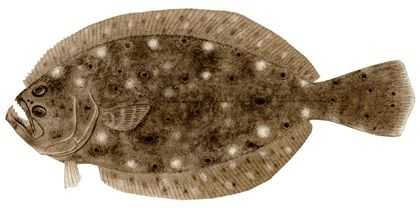Summer Flounder

Species Details
Paralichthys Dentatus
Paralichthyidae
Pleuronectiformes
Onshore, Nearshore, Offshore
1 - 5 lbs.
15" - 37"
Summer Flounder (Paralichthys dentatus) Fish Description
Summer Flounder are a flatfish species. This fish is one of several “sand flounders”, with both eyes on the left side of the head; this means that Summer Flounder live on the seafloor, lying on the blind side of their bodies, facing the open water column.
Summer Flounder are grayish-brown with lighter spots, helping them blend in with the areas surrounding the seabed. When they hatch from their eggs, the Summer Flounder resemble normal fish, with an eye on each side of the head. As they mature, the bones on the right side of the skull grow significantly faster, so the right eye and nostril slowly migrate to the left side. Their jaws do not change significantly, so they bite sideways, from left to right.
Diet and Size
Summer Flounder are active ambush predators, which mean that they utilize their camouflage to blend in with their surroundings to catch unsuspecting prey. They also chase them down using their excellent swimming ability when dealing with prey that move faster. Their diet consists of a variety of bony fish including the sand lance, menhaden, atlantic silverside, mummichog killifish, small bluefish, porgies and a wide range of invertebrates like crabs, shrimps, and squids.
The average Summer Flounder is typically 15-20 inches in length, though they have the capability to grow as large as 26 pounds and live up to 20 years. The females make up the largest and oldest specimens having a maximum observed age of 17 years, while male Flounder have a maximum observed age of 15 years.
Interesting Facts about Summer Flounder
- Summer Flounder are nicknamed “chameleons of the sea” since they are capable of changing their coloring to blend in with the texture and color of the bottom where they live.
- Most of the Summer Flounder spawn in the peak months of October and November when water temperatures change and plankton is at its most abundant period. Combining these elements improves the chance of survival for the larval Summer Flounder.
- Larval and juvenile Summer Flounder are preyed upon by species like spiny dogfish, monkfish, cod, hakes, sea raven, longhorn sculpin, and fourspot flounder until they grow large enough to fend for themselves. Adult Summer Flounders are preyed by large sharks, rays, and monkfish.
- Female Flounder have between 460,000 to more than 4 million eggs, hatching in waters of the continental shelf.
- A permit is required for the sale and purchase of the summer flounder
Summer Flounder Fishing Techniques
Summer Flounder can be fished all year round, but they're easier to catch between September and November. Summer Flounder have a great response to live fish such as minnow, mullet and croakers. Sea worms and clams are also effective baits that Summer Flounder love. It is recommended that you use a circle hook, because it is easier for Flounders to bite.
An effective angling technique would be hooking smaller baitfish through the eye and larger baitfish through the lips. Using a casting rod which is 7 ft long is the standard method of anglers for catching Flounder. It is advised that you use a line that's sturdy enough to handle larger fish that might take the bait. You may need a sinker to make sure the hook is within reach of the Flounder down below
Summer Flounder Habitat & Distribution
Summer Flounder are mainly found in the East Coast of the United States and Canada. They are very abundant in the waters stretching from North Carolina to Massachusetts. Summer Flounder also thrive best from Nova Scotia to the eastern part of Florida.
This fish is usually located offshore and inshore, especially in estuaries. They are demersal; thus, Summer Flounder are usually captured using bottom otter trawls or by gillnets and pound nets.







